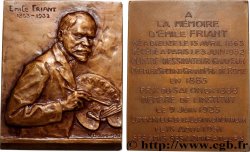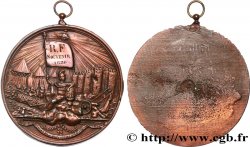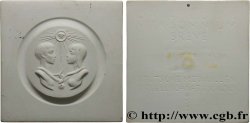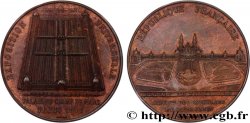E-auction 460-372579 - fme_728757 - III REPUBLIC Médaille, Palais du Champ de Mars / Trocadéro
得先注册又得到批准才可以报价。为了报价注册. 客户应该得到公司允许,那种过程需要 48 个小时。别等出售结束那一天才登记。您报价的话等于您赞成买那物品,而且按« 保价 » 证明您接受 cgb.fr 因特网拍卖使用法.
报价时只可以出全数值欧元总额。物品描述也说明销售结束时间,结束后出价都不会生效。 报价命令转达有时变动,等到最后秒钟增加否决的可能会。想多了解的话请注意 因特网拍卖常问
购货人不付费
购货人不付费
| 估算 : | 80 € |
| 价格 : | 42 € |
| 最高出价 : | 80 € |
| 拍卖结束日期 : | 07 February 2022 18:45:30 |
| 竞拍人 : | 7 竞拍人 |
种类 Médaille, Palais du Champ de Mars / Trocadéro
日期: 1878
铸币厂名称/城市 75 - Paris
材质 bronze
直径 46,15 mm
模子方针 12 h.
硬币制模工 LAGRANGE Jean (1831-1908) / DUBOIS Alphée (1831-1905)
重量 61,51 g.
侧面 lisse + abeille BRONZE
印模 Abeille (1860 - 1880)
关于品相的说明
Joli exemplaire présentant peu d’usure. Traces de manipulation dans les champs. Présence de quelques légères rayures
正面
正面的文字 EXPOSITION UNIVERSELLE // PALAIS DU CHAMP DE MARS / PARIS 1878.
正面的说明书 Vue du Palais du champ de Mars, signé : LAGRANGE.
背面
背面的文字 REPUBLIQUE FRANCAISE // PALAIS DU TROCADERO / ADMINISTRATION DES MONNAIES / ET MEDAILLES.
背面的说明书 Vue du palais du Trocadéro, avec ses escaliers monumentaux et ses jardins. Signé : ALPHEE DUBOIS.
评论
Le palais du Trocadéro était une construction de la seconde moitié du XIXe siècle de tendance éclectique, d'inspirations mauresque et néo-byzantine situé dans le 16e arrondissement de Paris, sur la colline de Chaillot, entre la place du Trocadéro et les jardins du même nom. Il était composé d'une salle de spectacle de 4 600 places prolongée de chaque côté par deux ailes courbées, accueillant chacune un musée (le musée des Monuments français et le musée d'ethnographie) et des salles de conférences.
Construit à l'occasion de l'exposition universelle de 1878, il n'était pas destiné à survivre à l'événement ; si le bâtiment est finalement conservé pendant une soixantaine d'années, il est l'objet de nombreuses critiques concernant son style architectural, son progressif délabrement et la mauvaise acoustique de la grande salle, rapidement désertée par les orchestres. Il est démantelé en 1935 pour l'exposition spécialisée de 1937, afin de laisser la place à une nouvelle construction, le palais de Chaillot.
The Palais du Trocadéro was a building from the second half of the 19th century of eclectic tendency, inspired by Moorish and neo-Byzantine styles, located in the 16th arrondissement of Paris, on the Chaillot hill, between the Place du Trocadéro and the gardens of the same name. It consisted of a 4,600-seat performance hall extended on each side by two curved wings, each housing a museum (the Museum of French Monuments and the Museum of Ethnography) and conference rooms. Built for the 1878 World's Fair, it was not intended to survive the event; although the building was ultimately preserved for around sixty years, it was the subject of much criticism concerning its architectural style, its gradual decay and the poor acoustics of the main hall, which was quickly deserted by orchestras. It was dismantled in 1935 for the 1937 special exhibition, to make way for a new building, the Palais de Chaillot.
Construit à l'occasion de l'exposition universelle de 1878, il n'était pas destiné à survivre à l'événement ; si le bâtiment est finalement conservé pendant une soixantaine d'années, il est l'objet de nombreuses critiques concernant son style architectural, son progressif délabrement et la mauvaise acoustique de la grande salle, rapidement désertée par les orchestres. Il est démantelé en 1935 pour l'exposition spécialisée de 1937, afin de laisser la place à une nouvelle construction, le palais de Chaillot.
The Palais du Trocadéro was a building from the second half of the 19th century of eclectic tendency, inspired by Moorish and neo-Byzantine styles, located in the 16th arrondissement of Paris, on the Chaillot hill, between the Place du Trocadéro and the gardens of the same name. It consisted of a 4,600-seat performance hall extended on each side by two curved wings, each housing a museum (the Museum of French Monuments and the Museum of Ethnography) and conference rooms. Built for the 1878 World's Fair, it was not intended to survive the event; although the building was ultimately preserved for around sixty years, it was the subject of much criticism concerning its architectural style, its gradual decay and the poor acoustics of the main hall, which was quickly deserted by orchestras. It was dismantled in 1935 for the 1937 special exhibition, to make way for a new building, the Palais de Chaillot.








 对产品描述纠错
对产品描述纠错 打印
打印 分享我的选择
分享我的选择 提问
提问 Consign / sell
Consign / sell
 产品介绍
产品介绍














